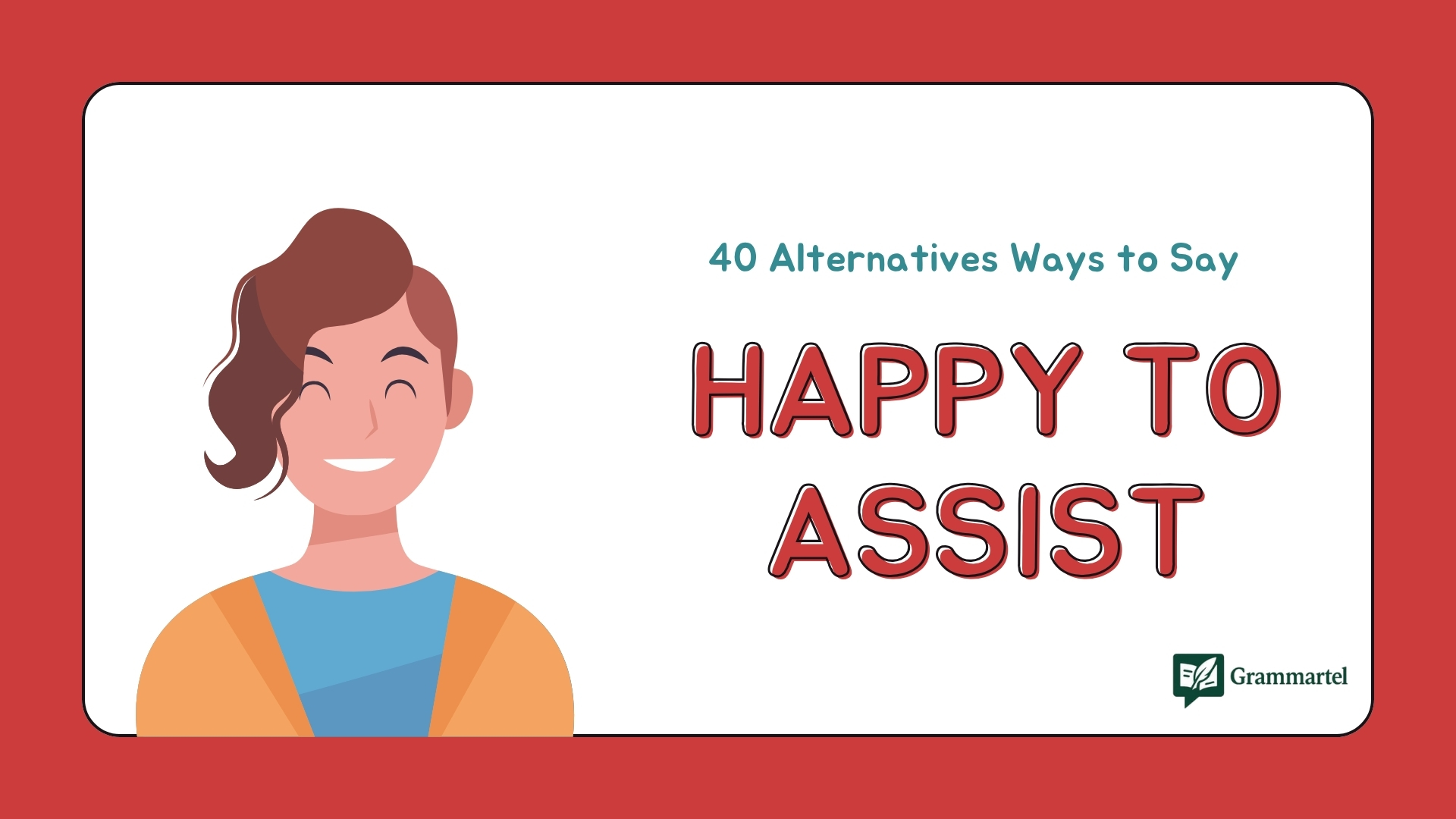When helping others, it’s important to express willingness and enthusiasm in different ways. Instead of saying the common “happy to assist,” you can use many other phrases to convey the same idea while keeping the conversation fresh and engaging. These alternatives can be used in both formal and casual settings, making your communication more versatile and interesting. Here are 40 different ways to express your readiness to help someone.
What Does “Happy to Assist” Mean?
“Happy to assist” is a polite and friendly way of saying you are ready and willing to help someone. It shows that you are eager to offer support and makes the person feel comfortable reaching out for help. It’s often used in customer service, emails, or conversations to convey a positive and helpful attitude.
When to Use “Happy to Assist”
You can use “happy to assist” when offering help or support to someone. It’s commonly used in professional settings, especially in customer service, emails, or business interactions. You can say it when responding to requests or when you’re available to help someone with their needs. It shows your willingness to be of service in a warm and respectful way.
40 Alternatives Ways to Say “Happy to Assist”
1. Glad to Help
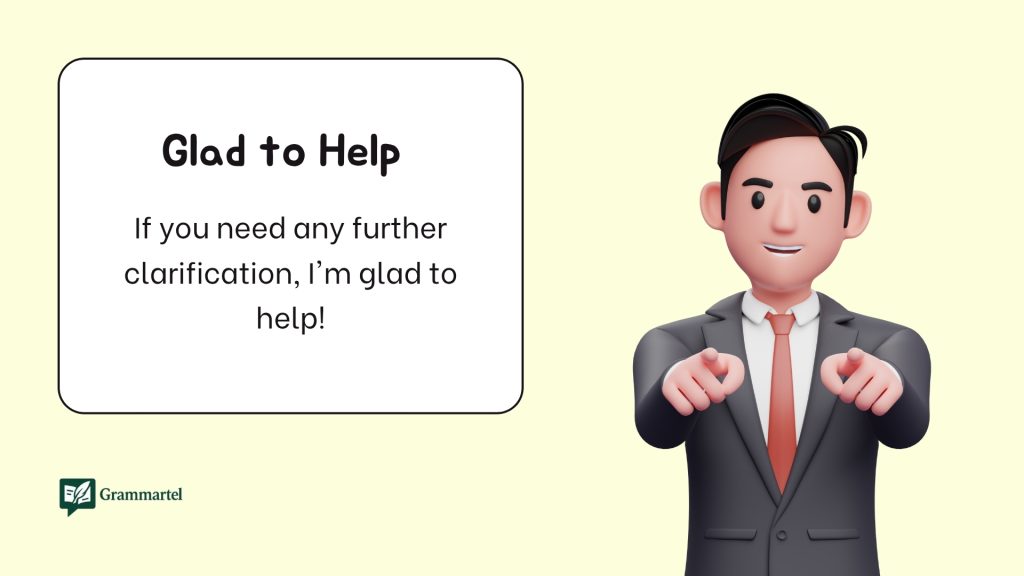
- Meaning: Expresses enthusiasm and positivity about offering assistance.
- Explanation: Indicates a warm willingness to help someone with a task or need.
- Example: “If you need any further clarification, I’m glad to help!”
- Best Use: In customer service, when addressing someone politely and with eagerness.
- Worst Use: When addressing an urgent, serious situation requiring formal language.
- Tone: Friendly, warm
2. Happy to Assist
- Meaning: Indicates a pleasant readiness to provide support.
- Explanation: A formal but friendly way of saying you’re available to help.
- Example: “If you need anything else, I’m happy to assist!”
- Best Use: In professional emails or conversations.
- Worst Use: In casual or informal contexts, it might sound too stiff.
- Tone: Formal, courteous
3. Always Here to Help
- Meaning: Suggests constant availability and readiness to offer support.
- Explanation: Implies that the person can always rely on your assistance.
- Example: “Don’t hesitate to ask, I’m always here to help!”
- Best Use: When you want to show consistent availability to a colleague or client.
- Worst Use: When responding to a situation where you can’t be available all the time.
- Tone: Supportive, reassuring
4. Glad to Be of Service
- Meaning: A polite way of expressing your pleasure in helping someone.
- Explanation: Indicates you find satisfaction in helping and are grateful to do so.
- Example: “It was my pleasure! Glad to be of service.”
- Best Use: In professional or customer service situations.
- Worst Use: In a very casual or informal setting, as it may come off as too formal.
- Tone: Formal, professional
5. Delighted to Help
- Meaning: Conveys a sense of joy in offering assistance.
- Explanation: Indicates that you are not just willing but genuinely happy to assist.
- Example: “Delighted to help! Let me know if you need more information.”
- Best Use: When trying to be especially polite or enthusiastic in professional contexts.
- Worst Use: In a rushed or stressed situation where you don’t have time to offer a warm response.
- Tone: Enthusiastic, warm
6. Pleased to Assist
- Meaning: A formal yet friendly way to offer help.
- Explanation: Suggests professionalism with a hint of politeness.
- Example: “I’m pleased to assist with any further questions you may have.”
- Best Use: In professional emails or formal communications.
- Worst Use: In informal or casual situations, as it might sound too stiff.
- Tone: Polite, formal
Don’t forget to read : 40 Better Ways to Say “I Will Let You Know” (With Real-Life Examples).
7. At Your Service
- Meaning: A phrase expressing that you’re available and ready to help.
- Explanation: Shows eagerness and an open willingness to assist.
- Example: “Let me know what you need, I’m at your service!”
- Best Use: In professional service or hospitality industries.
- Worst Use: In casual interactions where it may sound overly formal.
- Tone: Respectful, formal
8. Eager to Help
- Meaning: Shows excitement and enthusiasm to offer assistance.
- Explanation: Indicates you are not only available but excited to help.
- Example: “If there’s anything else you need, I’m eager to help!”
- Best Use: In situations where enthusiasm is appreciated, like customer service or sales.
- Worst Use: In high-pressure situations where a more serious tone is needed.
- Tone: Enthusiastic, energetic
9. Here to Help
- Meaning: A simple and direct expression that conveys availability.
- Explanation: Directly states your willingness to provide support.
- Example: “Don’t hesitate to reach out, I’m here to help!”
- Best Use: In both professional and casual contexts where simplicity is needed.
- Worst Use: When addressing very formal or authoritative individuals.
- Tone: Friendly, casual
10. It’s My Pleasure
- Meaning: A polite way of saying you are happy to help.
- Explanation: Conveys a sense of enjoyment and gratitude in assisting.
- Example: “It’s my pleasure to help you with that request.”
- Best Use: In customer-facing situations to express your willingness to go the extra mile.
- Worst Use: In a rushed situation where it may seem like you’re taking time unnecessarily.
- Tone: Friendly, polite
11. Count on Me
- Meaning: Indicates you are dependable and ready to provide support.
- Explanation: Suggests that the person can trust you to offer help when needed.
- Example: “If you need anything, just count on me!”
- Best Use: In situations where you’re showing reliability and dependability.
- Worst Use: In situations where you may not actually be able to help.
- Tone: Reassuring, friendly
12. More Than Happy to Help
- Meaning: Indicates that you’re not just willing but actually very happy to assist.
- Explanation: A more enthusiastic version of “happy to help.”
- Example: “I’m more than happy to help you with this!”
- Best Use: In casual or enthusiastic interactions where you want to show extra eagerness.
- Worst Use: In overly serious or formal settings where too much enthusiasm may feel out of place.
- Tone: Enthusiastic, friendly
13. Feel Free to Ask
- Meaning: Encourages someone to reach out if they need assistance.
- Explanation: A casual way of showing you’re available and open to helping.
- Example: “Feel free to ask if you need more information.”
- Best Use: In casual, non-urgent interactions.
- Worst Use: In formal settings where a more structured response might be preferred.
- Tone: Casual, inviting
14. I’m Here for You
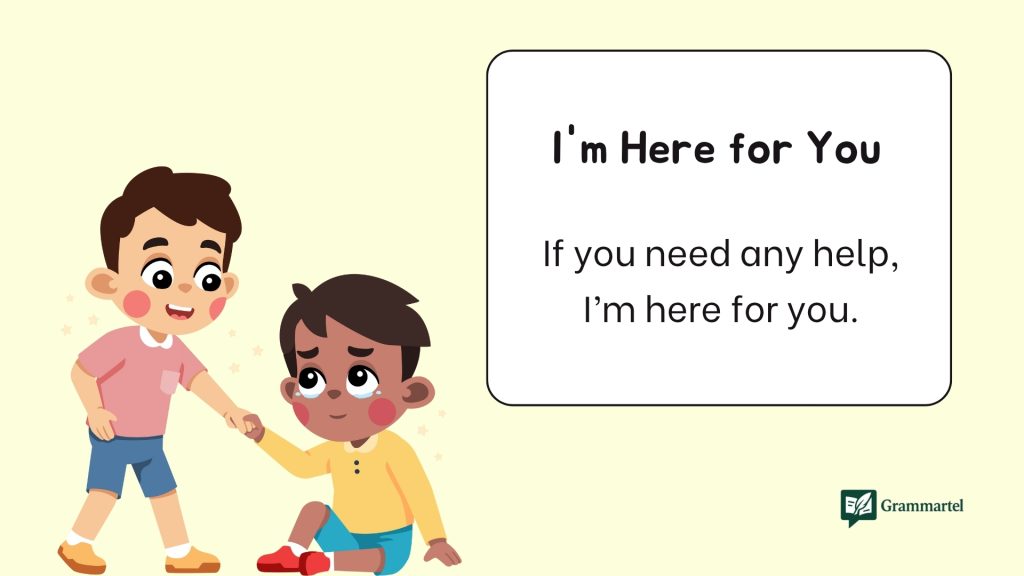
- Meaning: Expresses emotional or practical support.
- Explanation: A comforting phrase to let someone know you are available and ready to help.
- Example: “If you need any help, I’m here for you.”
- Best Use: In situations where emotional support or reassurance is needed.
- Worst Use: When the person just needs a quick, simple answer.
- Tone: Supportive, empathetic
15. No Problem
- Meaning: A casual way of indicating that helping is not an inconvenience.
- Explanation: Implies that the task is easy and doesn’t cause any trouble.
- Example: “You’re welcome—no problem at all!”
- Best Use: In casual settings or when offering help that doesn’t require much effort.
- Worst Use: In formal or professional contexts, as it may sound too informal.
- Tone: Casual, laid-back
16. It’s No Trouble
- Meaning: Another way of saying that helping someone is not a burden.
- Explanation: Shows you are willing to help without any inconvenience to yourself.
- Example: “Don’t worry, it’s no trouble to assist you with that.”
- Best Use: In informal or lighthearted situations.
- Worst Use: In formal or professional situations where more politeness is required.
- Tone: Casual, friendly
17. I’m at Your Disposal
- Meaning: Implies that you are available and willing to assist in any way necessary.
- Explanation: A formal and polite phrase indicating availability.
- Example: “Should you need anything further, I’m at your disposal.”
- Best Use: In professional or formal settings.
- Worst Use: In casual conversations where it might sound too stiff or distant.
- Tone: Formal, respectful
18. You Can Count on Me
- Meaning: Reinforces your reliability and availability.
- Explanation: Suggests that the person can trust you to offer support when needed.
- Example: “If you ever need help, just know you can count on me.”
- Best Use: When reassuring someone of your support or assistance.
- Worst Use: When it is not actually possible for you to help them, as it might break trust.
- Tone: Reassuring, dependable
19. Ready to Assist
- Meaning: States your preparedness to offer help.
- Explanation: A formal way of indicating that you’re ready and available to assist.
- Example: “Feel free to reach out—I’m ready to assist with any issues.”
- Best Use: In a professional setting when you are making yourself available for support.
- Worst Use: In casual conversations, as it might sound overly formal.
- Tone: Formal, professional
20. It’s an Honor to Help
- Meaning: Conveys pride and a sense of respect in helping someone.
- Explanation: Implies that offering help is something you value and appreciate.
- Example: “It’s an honor to help you with this matter.”
- Best Use: In very formal or respectful interactions.
- Worst Use: In casual, everyday scenarios where it might come off as too stiff.
- Tone: Respectful, formal
21. More Than Willing to Help
- Meaning: Indicates that you’re not only able but also eager to assist.
- Explanation: Emphasizes an enthusiastic willingness to help beyond the minimum.
- Example: “I’m more than willing to help you get that sorted.”
- Best Use: When offering a helpful hand in a positive, can-do situation.
- Worst Use: When it’s clear that you can’t fully assist, as it may create unrealistic expectations.
- Tone: Eager, positive
22. Glad to Lend a Hand
- Meaning: A more casual and friendly expression of being happy to assist.
- Explanation: “Lend a hand” is a colloquial way of saying you’re offering help.
- Example: “I’m glad to lend a hand with the preparations.”
- Best Use: In casual or informal situations where you want to express a helping attitude.
- Worst Use: In formal or serious situations where a more professional tone is needed.
- Tone: Casual, friendly
23. I’m Here to Serve
- Meaning: A formal expression that shows your readiness to offer assistance.
- Explanation: Indicates you’re available and at the person’s service, often used in customer service or hospitality contexts.
- Example: “If you have any requests, I’m here to serve.”
- Best Use: In formal or service-oriented professions.
- Worst Use: In casual or informal settings, where it might come off as overly formal.
- Tone: Professional, formal
24. Ready and Willing to Help
- Meaning: Shows that you are both mentally and practically prepared to assist.
- Explanation: Emphasizes both readiness and eagerness to offer assistance.
- Example: “I’m ready and willing to help you complete this task.”
- Best Use: In professional settings where a clear statement of availability is needed.
- Worst Use: In situations where you’re unsure of your ability to assist.
- Tone: Determined, professional
25. I’m Available to Assist
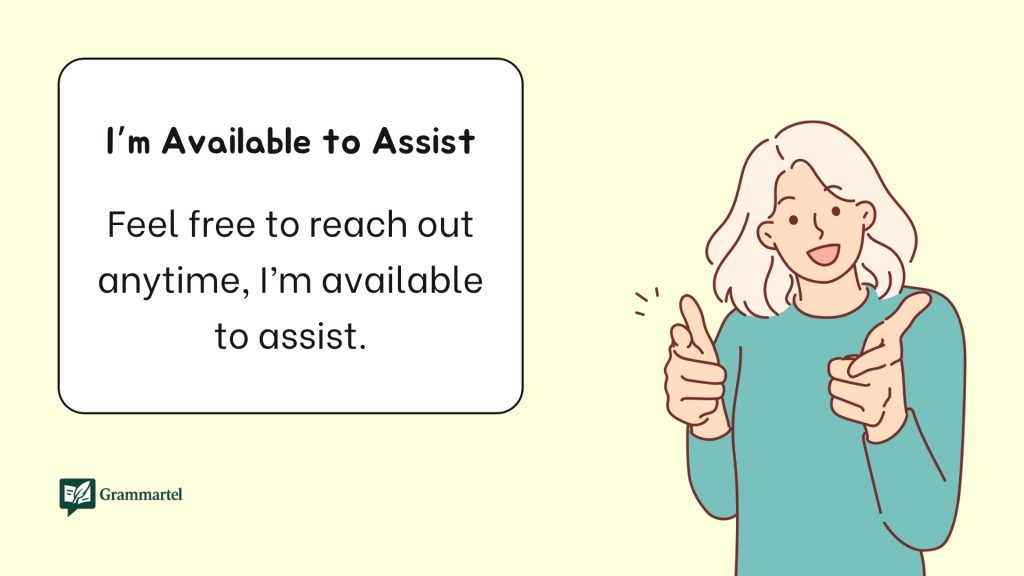
- Meaning: A formal and straightforward expression of your availability.
- Explanation: Letting the other person know you’re free and able to help.
- Example: “Feel free to reach out anytime, I’m available to assist.”
- Best Use: In professional or business contexts where you want to show readiness to help.
- Worst Use: In informal or social conversations, where it might sound too formal.
- Tone: Professional, neutral
26. I’m Happy to Lend My Expertise
- Meaning: Indicates your readiness to help with knowledge or skills.
- Explanation: Suggests that you’re not only offering help but also providing specialized knowledge.
- Example: “I’m happy to lend my expertise if you need assistance with the project.”
- Best Use: When offering help in areas that require specific knowledge or skills.
- Worst Use: When you’re not particularly an expert in the subject, as it may seem misleading.
- Tone: Professional, confident
27. It Would Be a Pleasure to Assist
- Meaning: A formal, respectful way of offering help with a positive attitude.
- Explanation: Highlights that you find it enjoyable to offer your assistance.
- Example: “It would be a pleasure to assist you with the report.”
- Best Use: In formal or professional situations, especially where politeness is important.
- Worst Use: In casual conversations, as it might come off as overly formal.
- Tone: Formal, polite
28. At Your Service, Always
- Meaning: An assurance that you are always ready and willing to assist.
- Explanation: A more formal way of saying you are available to help at any time.
- Example: “If you need further support, I’m at your service, always.”
- Best Use: In customer service or hospitality situations where you want to show ongoing availability.
- Worst Use: In personal conversations where the phrase might sound too stiff.
- Tone: Formal, respectful
29. Willing to Help in Any Way
- Meaning: A flexible expression indicating that you’re ready to assist in any capacity.
- Explanation: Suggests a readiness to help with any aspect or detail that the person needs.
- Example: “I’m willing to help in any way that would be useful to you.”
- Best Use: In situations where you want to show your flexibility and broad willingness to assist.
- Worst Use: In situations where you have limitations in what you can help with.
- Tone: Flexible, accommodating
30. Feel Free to Reach Out
- Meaning: Encourages the person to contact you when they need help.
- Explanation: A casual way to offer your assistance and let someone know you’re open to communication.
- Example: “Feel free to reach out if you need help with anything!”
- Best Use: In casual or semi-professional settings, encouraging someone to ask for help.
- Worst Use: In formal situations, where a more structured invitation to help is required.
- Tone: Casual, approachable
31. I’m All Ears
- Meaning: A friendly, informal way of expressing that you’re ready to listen and help.
- Explanation: Indicates that you’re eager to listen and offer assistance.
- Example: “I’m all ears! Let me know how I can help.”
- Best Use: In casual settings or when offering advice or support.
- Worst Use: In formal or business contexts, where a more professional tone is needed.
- Tone: Friendly, informal
32. Pleased to Be of Assistance
- Meaning: A polite way of saying you’re happy to offer help.
- Explanation: Expresses satisfaction in providing support to someone.
- Example: “It’s been a pleasure to be of assistance. Let me know if you need more help.”
- Best Use: In formal settings or customer service situations.
- Worst Use: In casual conversations, where it might sound overly formal.
- Tone: Polite, formal
33. Always Happy to Lend a Hand
- Meaning: A casual, friendly expression of your willingness to help.
- Explanation: Shows that you are consistently available and willing to assist in a friendly manner.
- Example: “I’m always happy to lend a hand whenever you need it.”
- Best Use: In casual, friendly interactions where you want to show your support.
- Worst Use: In formal or business contexts, where it may seem too informal.
- Tone: Friendly, approachable
34. I’m Happy to Provide Assistance
- Meaning: A formal way of expressing your willingness to offer help.
- Explanation: Suggests a more serious, yet polite, commitment to help.
- Example: “I’m happy to provide assistance with your inquiries.”
- Best Use: In formal or business communications where a polite offer of help is appropriate.
- Worst Use: In informal or lighthearted settings where it may seem too stiff.
- Tone: Formal, polite
35. Delighted to Be of Service
- Meaning: A courteous way to express pleasure in offering help.
- Explanation: Highlights that you find it genuinely enjoyable to help someone.
- Example: “It was delightful to be of service today. Let me know if you need anything else.”
- Best Use: In formal or service-related situations where you want to express gratitude for the opportunity to assist.
- Worst Use: In casual settings, where the phrase may sound too formal or pretentious.
- Tone: Formal, enthusiastic
36. Happy to Lend My Hand
- Meaning: A friendly expression of your willingness to help.
- Explanation: A simple, casual way to let someone know you’re ready to help.
- Example: “Don’t hesitate to ask—happy to lend my hand!”
- Best Use: In informal settings or when offering help with a specific task.
- Worst Use: In formal business contexts, where it may seem too informal.
- Tone: Friendly, casual
37. I’m Available for Anything You Need
- Meaning: Indicates flexibility and readiness to assist in any way.
- Explanation: Shows that you’re open to helping with whatever is necessary.
- Example: “Feel free to reach out—I’m available for anything you need.”
- Best Use: When showing openness and flexibility to help someone.
- Worst Use: In situations where you are unable to help with all requests.
- Tone: Flexible, accommodating
Be sure to read : 40 Polite Ways to Say “Meet and Greet” (With Examples).
38. I’m Happy to Take Care of That
- Meaning: A straightforward way to offer assistance, implying responsibility.
- Explanation: Shows that you’re happy to take responsibility for a task or problem.
- Example: “I’m happy to take care of that issue for you.”
- Best Use: When offering to handle a task or resolve a problem.
- Worst Use: When you are not actually able to take care of the task or problem.
- Tone: Confident, responsible
39. I’d Be Glad to Help
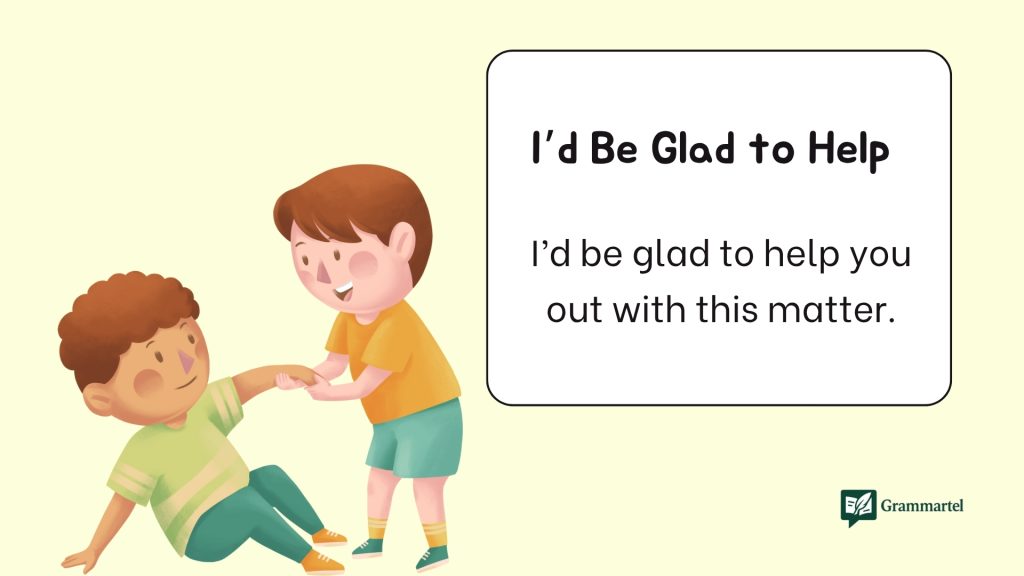
- Meaning: A polite way to say that you’re happy to assist.
- Explanation: Offers your help in a courteous and friendly manner.
- Example: “I’d be glad to help you out with this matter.”
- Best Use: In both formal and informal settings, offering help with a positive attitude.
- Worst Use: In a very urgent or critical situation where more direct or urgent help is needed.
- Tone: Friendly, polite
40. More Than Happy to Lend a Hand
- Meaning: Shows both eagerness and willingness to help.
- Explanation: Indicates that you are excited and ready to assist in any way possible.
- Example: “I’m more than happy to lend a hand with your presentation.”
- Best Use: In casual or collaborative settings where enthusiasm is appreciated.
- Worst Use: In serious or formal scenarios where a more professional tone is needed.
- Tone: Enthusiastic, friendly
Conclusion
Using varied expressions to show you’re ready to help can make your communication more engaging. Whether in professional emails or casual conversations, trying out different phrases keeps things lively and can make the person you’re assisting feel valued. Remember, a small change in wording can have a big impact on how your message is received.
Discover more insightful reads by visiting Grammartel regularly.

